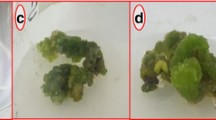Summary
Dihydroleucodin, the main secondary metabolite fromArtemisia douglasiana, showed cytoprotective activity against chemically induced peptic ulcer in rats. In this work, cell lines ofA. douglasiana were used to study the kinetic of growth and dihydroleucodin production.
Similar content being viewed by others
References
Dougall, D. K. (1985) in Biotechnology in Plant Science. p. 179–190. Edited by Zaitlin M., Day P., Hollaender A.
Fujita Y., Takahashi, S., Yamada Y. (1985). Agric. Biol. Chem. 49 (6) 1755–1759.
Khana P., Staba E. J. (1968). Jour. of Nat. Prod. Lloydia, 31: 180–189.
Murashige T., Skoog F. (1962). Physiol. Plant, 15: 473–497.
Author information
Authors and Affiliations
Rights and permissions
About this article
Cite this article
Pestchanker, L.J., Kurina, M., Giulietti, A.M. et al. Production of dihydroleucodin from callus lines of Artemisia douglasiana besser. Biotechnol Lett 11, 803–806 (1989). https://doi.org/10.1007/BF01026101
Issue Date:
DOI: https://doi.org/10.1007/BF01026101




